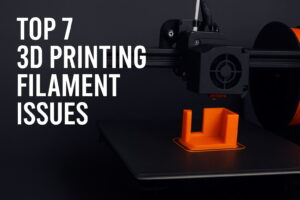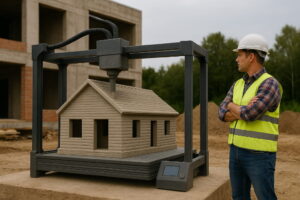3D printing has transformed the way we create prototypes, tools, and everyday objects. But as exciting as it is, beginners and even experienced users often face common filament-related issues that can ruin a print. The good news? With the right knowledge, you can solve most of these problems like a pro.
In this article, we’ll cover the top 7 3D printing filament issues and explain how to fix them in simple, easy-to-understand steps.
1. Filament Not Sticking to the Bed
One of the most common problems is when your filament won’t stick to the print bed. This leads to failed prints or messy results.
Causes:
- Bed not leveled properly
- Dirty or greasy build surface
- Wrong bed temperature
Fix:
- Level your bed before every print.
- Clean the surface with isopropyl alcohol.
- Use adhesives like glue stick, painter’s tape, or build surface sheets.
- Adjust bed temperature depending on the filament (e.g., PLA works best at 50–60°C).
2. Stringing or Oozing
Do you see thin, unwanted strings between parts of your print? That’s stringing.
Causes:
- Retraction settings not optimized
- Printing temperature too high
Fix:
- Enable and fine-tune retraction in your slicer.
- Lower the nozzle temperature slightly (2–5°C at a time) until stringing reduces.
- Increase travel speed to minimize filament leakage.
3. Clogged Nozzle
A clogged nozzle can completely stop your print.
Causes:
- Dust or dirt in the filament
- Using low-quality filaments
- Printing at wrong temperatures
Fix:
- Use a needle or cleaning filament to clear the nozzle.
- Regularly perform “cold pulls” to clean it from the inside.
- Always store filament in airtight containers to prevent dust and moisture.

4. Warping and Curling
If your print corners lift off the bed, it’s warping.
Causes:
- Uneven cooling of the filament
- Printing large flat parts without proper adhesion
Fix:
- Use a heated bed and keep the enclosure closed.
- Apply adhesives (like ABS slurry or glue stick).
- Print with a brim or raft to hold the model in place.
- Maintain proper bed temperature (e.g., ABS requires 90–110°C).
5. Under-Extrusion
When your prints look weak or have missing layers, under-extrusion is likely the issue.
Causes:
- Blocked nozzle or worn-out extruder gear
- Incorrect filament diameter settings
- Printing too fast
Fix:
- Clean the nozzle and check for blockages.
- Verify filament diameter in your slicer matches the actual spool.
- Slow down the print speed for consistent extrusion.
6. Over-Extrusion
If too much filament is being pushed out, your prints may look blobby or messy.
Causes:
- Extrusion multiplier too high
- Wrong filament diameter settings
Fix:
- Reduce the extrusion multiplier/flow rate in your slicer.
- Measure the filament with calipers and update the slicer settings.
7. Filament Breaking or Snapping
Sometimes the filament itself becomes brittle and breaks.
Causes:
- Moisture absorption
- Old or poor-quality filament
- Storing filament improperly
Fix:
- Store filament in airtight containers with silica gel.
- Dry your filament using a filament dryer or oven (at a safe, low temperature).
- Always invest in high-quality filaments to avoid breakage.
Final Thoughts
3D printing is an amazing technology, but filament issues can be frustrating if you don’t know how to handle them. By understanding these top 7 filament problems and applying the fixes above, you can achieve smoother, cleaner, and more professional prints every time.
At 3DReality, we provide top-notch 3D printing services — from designing unique tools and accessories to delivering high-quality prints at affordable prices. We use premium-grade filaments with zero issues, ensuring your projects come out flawless.
Ready to bring your ideas to life without filament hassles? Contact 3DReality today and experience 3D printing like a pro.
Frequently Asked Questions About filaments issues
1. What is 3D printing filament?
3D printing filament is the thermoplastic material used in FDM 3D printers to create objects layer by layer. Common types include PLA, ABS, and PETG.
2. Why does my 3D printing filament not stick to the bed?
Poor bed adhesion happens when the bed isn’t leveled, the surface is dirty, or the bed temperature is incorrect. Cleaning and adjusting the bed usually fixes it.
3. How do I prevent stringing with 3D printing filament?
You can prevent stringing by enabling retraction, lowering the nozzle temperature, and increasing travel speed in your slicer settings.
4. How should I store 3D printing filament?
Always store filament in an airtight container with silica gel to protect it from moisture and dust, which can cause print quality issues.
5. What is the best 3D printing filament for beginners?
PLA is the best 3D printing filament for beginners because it’s easy to print, affordable, and works well without requiring a heated bed.


